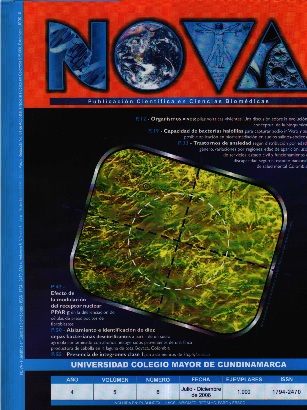Presencia de Integrones Clase 1 en Aislamientos de Staphylococcus epidermidis de las unidades de neonatología del Instituto Materno Infantil de Bogotá
Presencia de Integrones Clase 1 en Aislamientos de Staphylococcus epidermidis de las unidades de neonatología del Instituto Materno Infantil de Bogotá

NOVA por http://www.unicolmayor.edu.co/publicaciones/index.php/nova se distribuye bajo una Licencia Creative Commons Atribución-NoComercial-SinDerivar 4.0 Internacional.
Así mismo, los autores mantienen sus derechos de propiedad intelectual sobre los artículos.
Mostrar biografía de los autores
La multiresistencia a los antibióticos por bacterias Gram positivas, especialmente el Staphylococcus epidermidis, constituye un problema creciente de salud pública en las unidades neonatales. Uno de los mecanismos de resistencia bacteriana recientemente descrito es la presencia de integrones y cassettes genéticos. Existen más de 9 clases de integrones, siendo el de clase 1 el que con mayor frecuencia se encuentra implicado en cepas causantes de infección hospitalaria.
En este estudio, se determinó la presencia de integrones clase 1 en Staphylococcus epidermidis, provenientes de hemocultivos y puntas de catéter, que causaron infección nosocomial en las unidades neonatales del Instituto Materno Infantil de Bogotá, Colombia. De las 46 cepas estudiadas, se detectó la presencia del gen intI 1 en 21 de los aislamientos (45.7%). Este hallazgo, pionero en cepas bacterianas aisladas en neonatos, sugiere la necesidad de buscar cassettes genéticos que confieren resistencia a los diferentes antimicrobianos, para definir esquemas de tratamiento de infecciones nosocomiales causadas por estos microorganismos.
Visitas del artículo 164 | Visitas PDF 101
Descargas
- Ardic N, Sareyyupoglu B, Ozyurt M, Haznedaroglu T, Ilga U Investigation of aminoglycoside modifying enzyme genes in methicillin-resistant staphylococci: Microbiol Res. 2006;161:49-54.
- Cifuentes Y, Ruiz A, Leal A, Muñoz L, Herrera M, Jimenez L. Perfil microbiológico en asilamientos en Unidades Neonatales en un hospital de tercer nivel de Bogotá, Colombia. Rev. Salud Pública 2005; 7:191-205.
- Stockes H qnd Hall R. A novel family 9of potencially mobile DNA elements encoding site-specific gene integration finctions: integrons. Molec. Microbial. 1989; 3:1669-1683.
- Guillemont TrwB, the coupling protein involved in DNA transport during bacterial conjugation, is a DNA-dependent ATPase. Biochemistry 2005; 102:8156-8161.
- Gonzalez R, Mella S, Zemelman R, Bello H, Dominguez M. Integrones y cassettes genéticos de resistencia: estructura y rol frente a los antibacterianos. Rev. Méd. Chile, 2004; 132:619-626.
- Bennett, P and Howe T. Bacterial and bacteriophage genetics. In Topley & Wilson’s Microbiology and MicrobialInfections, 1998Vol. 2, Systematic Bacteriology, 9th edn, (Collier, L.,Balows, A. & Sussman, M., Eds), pp. 231–294. Arnold, London.
- Shi L, Zheng M, Xiao Z, Asakura M, Su J, Li L, Yamasaki S. Unnoticed spread of class 1 integrons in gram-positive clinical strains isolated in Guangzhou, China. Microbiol Immunol. 2006; 50:463-467.
- Nandi S, Maurer JJ, Hofacre C, Summers AO. Gram-positive bacteria are a major reservoir of Class 1 antibiotic resistance integrons in poultry litter. Proc Natl Acad Sci U. S A. 2004; 101:7118-7122.
- Nesvera J, Hochmannova J, and Patek M. An integron of class 1 is present on the plasmid Pcg4 front Gram positive bacterium Corynebacterium glutamicum FMS Microb. Lett. 1998; 169:391-395.
- Tauch A, Gotker S, Puhler A, Kalinowski J, and Thierbach G. The 27.8-Kb R-Plasmid pTET3 from Corynebacterium glutamicum encodes the aminoglycoside adenyltransferase gne cassette aadA9 and the regulated tetracycline efflux system Tet 33 flanked by active copies of the widespread insertion sequence IS6100. Plasmid 2002; 48:117-129.
- Collis CM, Hall RM. Expression of antibiotic resistance genes in the integrated cassettes of integrons. Antimicrob Agents Chemother. 1995; 39:155-162.
- Gonzalez G, Mella S, Zemelman R, Bello H and Dominguez Y. Integrones y cassettes genéticos de resistencia: estructura y rol frente a los antibacterianos. Rev. Méd. Chile, 2004, 132:619-626.
- Stokes HW, O’Gorman DB, Recchia GD, Parsekhian M, Hall RM. Structure and function of 59-base element recombination sites associated with mobile gene cassettes. Mol Microbiol. 1997; 26:731-45.
- Martinez-Freijo P, Fluid A, Schnitmitz F, Greck V, Verhoef J and Jones M. Class I integrons in Gram-negative isolates from different European hospital and association with decreased susceptibility to multiple antibiotics compounds. J. Antimicrob Cmeoter. 1998; 42:689-696.
- Fluit A and Schmitz F.-J. Resistance integrons and superintegrons, Clin. Microbio. Infec. 2004; 10:272-288.
- Pessoa- Silva C, Miyasaki C, de Almeida M, Kopelman B, Raggio R, Wey S. Neonatal late-onset bloodstream infection: attributable mortality, excess of length of stay and risk factors. Eur. J Epidemiol. 2002; 39:1034-1039.
- Cunha Ma de L, Lopes C, Rugolo L, Chalita L. clinical significance of coagulase-negative staphylococci isolated from neonates. J Pediatr (Rio J) 2002; 78:279-288.
- Cunha Mde L, Rugolo LM, Lopes CA. Study of virulence factors in coagulase-negative staphylococci isolated from newborns. Mem Inst Oswaldo Cruz. 2006; 101:661-668.
- Rowe-Magnus DA, Mazel D. The role of integrons in antibiotic resistance gene capture. Int J Med Microbiol. 2002; 292:115-125.
- Steve Rozen, Helen J. Skaletsky. 2000. Primer3 on the WWW for general users and for biologist programmers. In: Krawetz S, Misener S (eds) Bioinformatics Methods and Protocols: Methods in Molecular Biology. Humana Press, Totowa, NJ, pp 365-386. Source code available at http://fokker.wi.mit.edu/primer3/
- -----------------------------------------------------------------------
- DOI: http://dx.doi.org/10.22490/24629448.361





